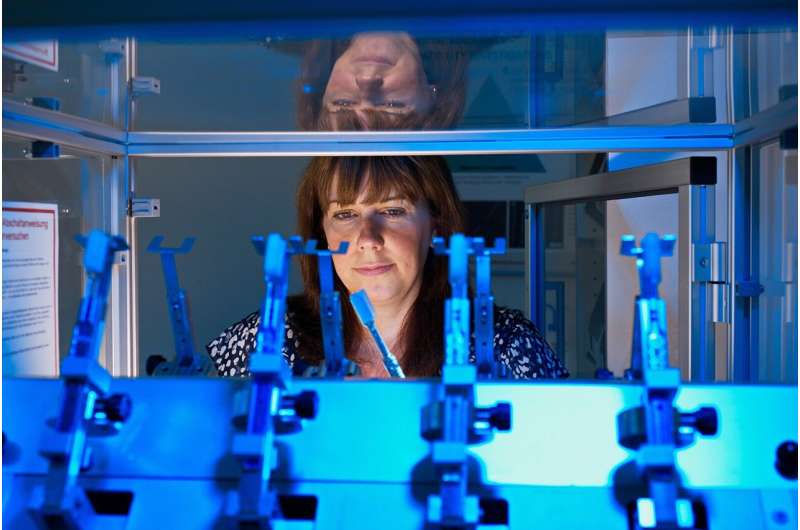This article has been reviewed according to Science X's editorial process and policies. Editors have highlighted the following attributes while ensuring the content's credibility:
fact-checked
trusted source
proofread
Just add milk: Choosing beverages wisely during chlorhexidine treatment

Antiseptic mouth rinses containing the active ingredient chlorhexidine (CHX) are widely used in dentistry. For many decades, CHX has set the gold standard for the management of oral diseases. During the treatment, however, tooth discoloration may occur after eating or drinking.
A comprehensive in-vitro study conducted by the Fraunhofer IMWS has investigated the degree to which various beverages cause potential discoloration during chlorhexidine treatment. Based on the data collected, dental staff can now offer improved recommendations to patients about what they should do during the treatment period, for example: They should ideally always add milk when drinking tea or coffee.
What sort of tooth discoloration can be caused by certain beverages while using mouth rinses containing CHX and how can the discoloration be reduced? The material science-based study carried out on behalf of GSK Consumer Healthcare (since renamed Haleon) was tasked with answering these questions.
Discoloration is a common side effect related to biochemical processes in the mouth: "The changes in color can occur because the positively charged chlorhexidine sticks to the negatively charged surfaces in the mouth—i.e., saliva, gingiva and enamel—and remains there for a long period of time.
"In contrast to proteins—an element of dental plaque, which the substance prevents from forming—dye molecules bind very easily to chlorhexidine. And the stronger or more permanent the binding, the more likely it is to cause discoloration," explains Dr. Sandra Sarembe, research scientist for the "Characterization of medical and cosmetic care products" research group at Fraunhofer IMWS. "The active ingredient chlorhexidine itself does not have any coloring properties."
Study design: Large variety of beverages
The pH value of individual beverages is one variable that determines which dye molecules bind particularly strongly to chlorhexidine. In order to be able to make the most conclusive recommendations on what to drink during the treatment period, the researchers at Fraunhofer IMWS selected a total of 11 beverages with varying pH values and different coloring, ranging from diet lemonade and ginger tea to coffee and black tea, both with and without milk. Water was used as reference.
A study with such breadth is the first of its kind: Before now, the degree to which different liquids can cause discoloration during chlorhexidine treatment has never been examined in such detail. The study design also included a model specifically created by the researchers to reproduce the processes in the mouth under as realistic conditions as possible. To do this, they used dental crowns that came into cyclical contact with artificial saliva, 0.2% CHX mouthwash and lastly the different beverages.
The team repeated the cycle a total of 28 times in order to simulate using chlorhexidine over a 14-day period—the typical length of time the mouthwash is used. In addition, the daily mechanical teeth cleaning with both water and toothpaste was reproduced using a toothbrushing simulator.
Layers of discoloration: Reduced durability with the addition of milk
The researchers used photographs to document and analyze the samples. They also carried out repeated color readings and analyzed the tooth surfaces using scanning electron microscopy. The results showed that consuming beverages with a high dye molecule content during CHX treatment causes persistent surface layers on the tooth.
"As expected, black tea and red wine caused the most noticeable discoloration; coffee or beer ranked somewhere in the middle. The deposits were much easier to remove by brushing with toothpaste compared to water alone, but this did not alter the overall ranking in terms of the severity of the discoloration," says Sarembe. "It was interesting to observe that by diluting black tea and coffee with milk, the structure of the resulting layer of discoloration changes and becomes significantly less durable."
Therefore, an important recommendation that dentists can offer to people receiving treatment is ideally to always add milk when drinking coffee and tea while using chlorhexidine. It is also recommended to consistently use toothpaste to brush your teeth and to leave as much time as possible between using mouthwash and eating or drinking.
Microstructure-based diagnostics, innovative model development
The researchers used methods such as scanning electron microscopy to visualize, document and analyze the structure of the individual layers of discoloration, which differed depending on the type of beverage and cleaning method. Specific test models like these, as well as specially adapted testing technologies, caused to make Fraunhofer IMWS a sought-after research partner for companies in the field of dental and oral hygiene for many years.
"In addition to microstructure-based diagnostics such as scanning electron microscopy (SEM) or computed tomography (µ-CT), surface-sensitive analysis methods such as ToF-SIMS (time-of-flight secondary ion mass spectrometry) are among our key areas of expertise," says Sarembe.
Combined with its comprehensive expertise in material science, the research group is able to encourage collaboration between science and industry, devise innovative solutions and strategies and optimize model development for studies—not just when it comes to investigating discoloration during chlorhexidine treatment.
The research was published in the European Journal of Dentistry.
More information: Sandra Sarembe et al, The Impact on Dental Staining Caused by Beverages in Combination with Chlorhexidine Digluconate, European Journal of Dentistry (2022). DOI: 10.1055/s-0041-1742123




















